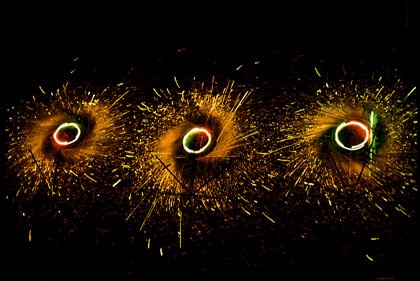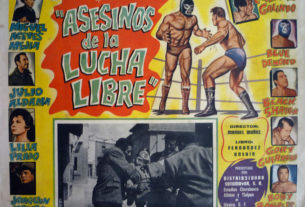Jose Zuñiga has been making castillos for the better part of 25 years. His father was a Maestro de Fuegos Artificiales, and from boyhood, he remembers being part of the family business. Today, he runs his own fabrica, with 5 men who help with the armature, delivery and illumination of Mexico’s favorite fiesta perk.

Castillos are lightweight towers of cane and wood, which support assorted arrays of colorful, often spinning, pyrotechnics. It’s literally a tower of fireworks, anywhere from 8 to 20 meters in height. No Mexican fiesta, civic or private, would be complete without at least one of these culturally unique creations lighting up the night. From the dangling cigarettes used to light the fuses and cohetes, to the squealing children running beneath the sparking towers with cardboard, nothing quite says Mexican party as colorfully as a castillo.
Though he admits that New Year’s Eve and the 12th of December are his biggest nights, Sr. Zuñiga says that he and his crew are busy all year round, making fireworks for weddings, birthdays, saint days and whatever other occasions his patrons dream up. He accommodates their wishes into his designs, giving color and shape choices, making suggestions from his quarter century of experience as a cohetero. He requires at least a month’s notice normally, two month’s for major holidays, as the work is meticulous and time consuming, not to mention dangerous if it’s done poorly.
In between orders, and for up to a month at a time, his crew is making and filling paper cartridges which they fill with colored, chemical explosives. These are eventually fused and attached to their appropriate frames, before being fired on the night of the display. These cartridges are just the beginning of a cohetero’s work; he now has to build the frame, which supports them, all for those few seconds of awe when they illuminate your fiesta.
The framework or armadura, is made from lightweight wood and cane, joisted by wire here and there, looking quite haphazard really, until it catches. Circles, spirals, and flowers, are prevalent shapes, attached along a vertical, central pole, which is stable, allowing the force of the ignited chemicals to spin crazily and bright along its axis.
Sr.Zuñiga transports his castillos in special trucks, arriving around four o’clock on the afternoon of a fiesta, and twenty minutes later, the castillo is erected. It generally takes five men, eight to ten days to assemble a 20m castillo, which will then go up in smoke in twenty minutes of visual joy. For these moments, Jose Zuñiga continues to practice his skill; the appreciation on the faces of people, as seen by the phosphorescent glow of his castillos. “It’s very satisfying, then,” he says.
The highlight of the castillo is the firing of the corona, which is typically the last hurrah for the cohetero. As a finale, the firework at the very top starts by spinning madly in place, showering sparks and fizzle, before shooting off, up to 100 m into the night sky! Where it lands is anybody’s guess. I wonder how many revelers have had the experience of a burnt corona landing on them. Regardless, Sr. Zuñiga assured me that in all his years of making and firing castillo’s, he has yet to suffer any major mishap or injury as a result. Care in the preparation, and respect for the basic rules of safety have assured that no one goes homne from the fiesta hurt.
This article appears courtesy of the Chapala Review, a monthly Newspaper published in Ajijic, Jalisco, Mexico. The focus is the Lake Chapala area. The goal is to provide quality information about the area, its stories, events, history, culture and people.

